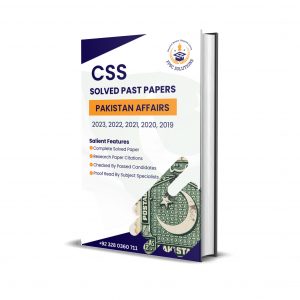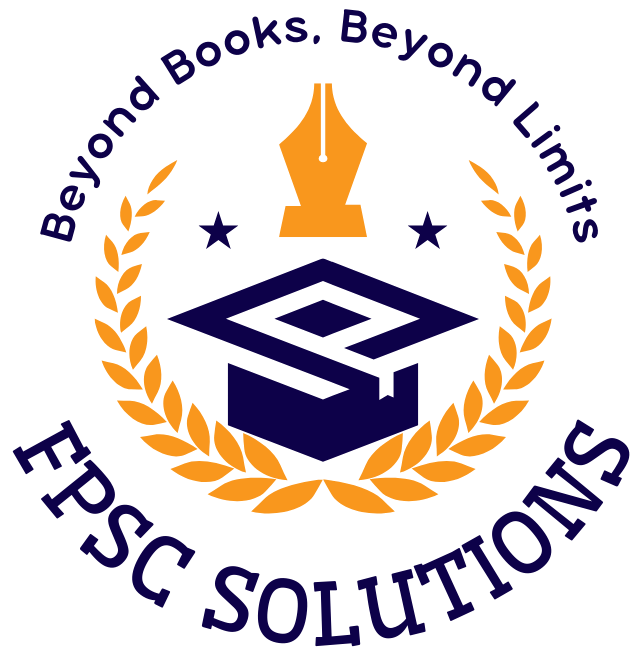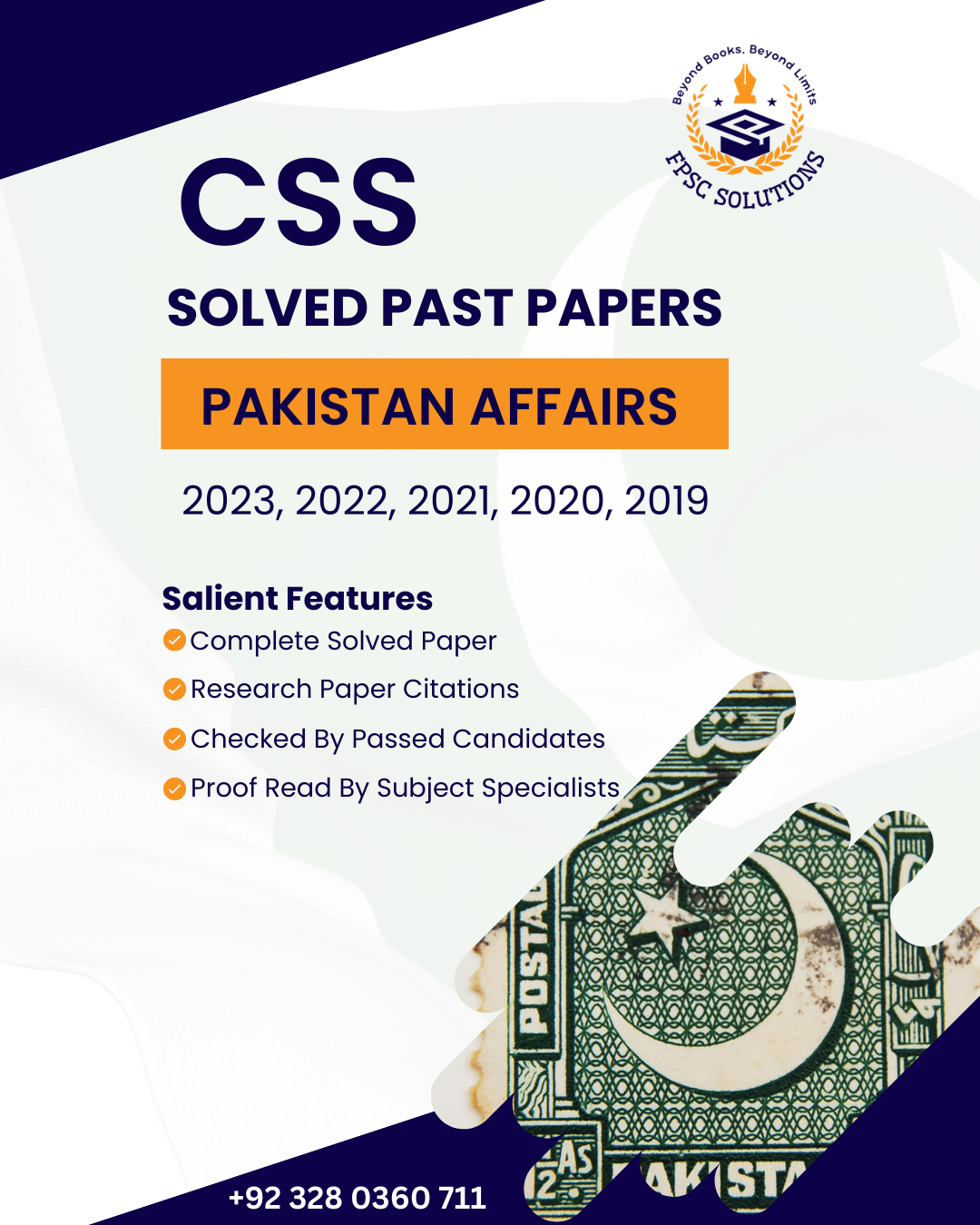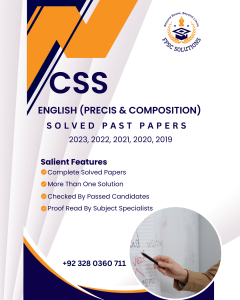In the competitive Exams like CSS, PMS, PPSC, FPSC, MPT where every detail matters, thoroughly understanding past papers can greatly impact candidate success. For those focusing on the CSS Exams, finding solved past papers solutions and preparation materials tailored to this year’s exam can provide a special edge.
This solved Solution offers clear and practical guidance for tackling the CSS Pakistan Affairs 2020 paper by breaking down each question and offering strategic advice for crafting compelling answers. They help candidates understand the structure and types of questions typically asked, allowing them to study strategies effectively. Working through past papers provides valuable practice, helping candidates refine their writing skills, manage their time, and assess their knowledge against model answers

CSS Pakistan Affairs Past Paper 2020
Q2. How the reform movement of Shaikh Ahmad Sir Hindi influenced the history of Muslim India?
Q3. China, Pakistan-Russia cooperation will find suitable support mechanisms in Shanghai Cooperation organization (SCO). Elaborate.
Q4. What are the major provisions of the Shimla Agreement (1972) between Pakistan and India? How it was helpful for the establishment of durable peace in the region?
Q5. What is meant by the term “Proxy War”? Are there any extrinsic factors at play in the internal security situation of Pakistan?
Q6. Discuss the main features of the Political culture of Pakistan.
Q7. Pakistan’s energy crisis was due to the lack of strategy and political will. Discuss.
Q8. Discuss the revival of Pak-US relations in the context of the present US-Taliban peace process.
A Student’s Guide to CSS Pakistan Affairs 2020 with Complete Citation
-

CSS PAKISTAN AFFAIRS SOLVED PAST PAPERS 2023, 2022, 2021, 2020, 2019
₨ 999 – ₨ 2,999Select options This product has multiple variants. The options may be chosen on the product page
Effective Strategies for solving Pakistan Affairs Past Paper 2020
Q2. How the reform movement of Shaikh Ahmad Sir Hindi influence the history of Muslim India?
To write a comprehensive essay on this topic, start with a brief introduction to Shaikh Ahmad Sir Hindi and his reform movement. Discuss his main ideas and how they challenged the existing socio-religious norms. Explain the impact of his reforms on the Muslim community in India, highlighting both immediate and long-term effects. Provide specific examples of changes brought about by his movement, such as shifts in educational and religious practices.
Q3. China, Pakistan-Russia cooperation will find suitable support mechanisms in the Shanghai Cooperation Organization (SCO). Elaborate.
Begin by outlining the role of the Shanghai Cooperation Organization (SCO) in international relations. Then, explain how cooperation between China, Pakistan, and Russia aligns with the SCO’s goals. Detail the support mechanisms provided by the SCO that can facilitate this cooperation, including economic partnerships, security collaborations, and regional stability efforts. Use recent examples to illustrate how these mechanisms have been employed or could be utilized.
Q4. What are the major provisions of the Shimla Agreement (1972) between Pakistan and India? How it was helpful for the establishment of durable peace in the region?
Start by summarizing the key provisions of the Shimla Agreement, such as the principle of bilateralism and the commitment to peaceful resolution of disputes. Analyze how these provisions aimed to create a framework for long-term peace. Discuss the immediate outcomes of the agreement and its impact on relations between Pakistan and India. Consider its effectiveness in reducing tensions and fostering dialogue.
Q5. What is meant by the term “Proxy War”? Are there any extrinsic factors at play in the internal security situation of Pakistan?
Define “Proxy War” and provide examples of historical and contemporary instances where proxy wars have occurred. Discuss how these wars influence internal security situations, using Pakistan as a case study. Identify and explain extrinsic factors, such as foreign interventions or regional conflicts, that contribute to Pakistan’s internal security issues.
Q6. Discuss the main features of the Political culture of Pakistan.
Begin by defining “political culture” and then outline its key features in the context of Pakistan. Discuss elements such as political participation, public opinion, party system, and governance. Provide examples of how these features manifest in Pakistan’s political landscape, including electoral processes, political behavior, and institutional practices.
Q7. Pakistan’s energy crisis was due to the lack of strategy and political will. Discuss.
Outline the key components of Pakistan’s energy crisis, including supply and demand issues, infrastructure challenges, and policy failures. Discuss how the lack of a coherent strategy and political will has exacerbated these problems. Provide examples of missed opportunities for reform and the consequences of ineffective policy decisions in the energy sector.
Q8. Discuss the revival of Pak-US relations in the context of the present US-Taliban peace process.
Provide an overview of the recent developments in Pak-US relations and the US-Taliban peace process. Discuss how these dynamics have influenced the bilateral relationship between Pakistan and the United States. Analyze the impact of the peace process on diplomatic and strategic interactions, including areas of cooperation and potential conflicts.
In conclusion, the CSS Pakistan Studies 2020 solved paper provides a valuable resource for aspirants preparing for the competitive examination. By understanding the thought process behind answering each question and the key concepts involved, candidates can enhance their chances of success in the exam. The solved paper also highlights the importance of staying updated with current affairs and regional dynamics, which are crucial for performing well in the Pakistan Studies section of the CSS exam.


